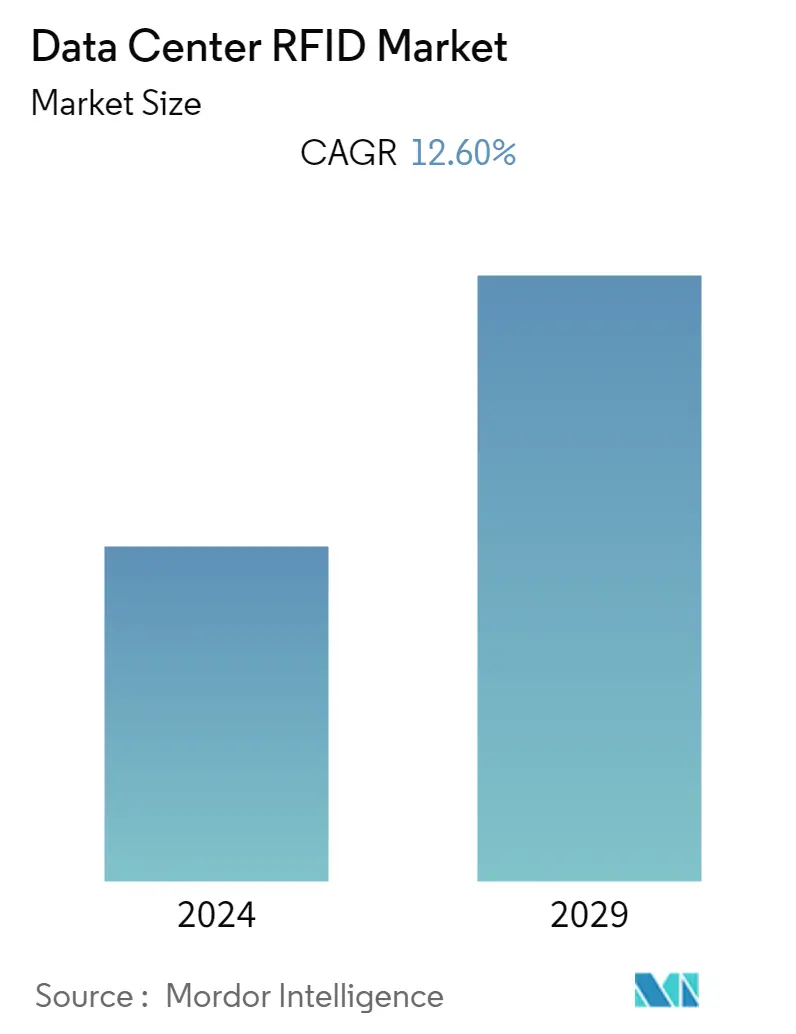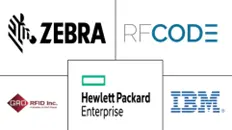Market Size of Data Center RFID Industry

| Study Period | 2019 - 2029 |
| Base Year For Estimation | 2023 |
| CAGR | 12.60 % |
| Fastest Growing Market | Asia-Pacific |
| Largest Market | North America |
| Market Concentration | Low |
Major Players
*Disclaimer: Major Players sorted in no particular order |
Data Center RFID Market Analysis
The Global Data Center RFID Market is expected to grow at a CAGR of 12.6% for the next five years. The sector's expansion is attributed to several causes, including the increasing need for data centers globally and the requirement for real-time asset information to lower associated risks.
- Data centers are important resources for contemporary life. The growth and popularity of the internet, mobile devices, and the Internet of Things (IoT) create a large quantity of information and data storage capacity. Asset management is made possible with the use of radio frequency identification (RFID), which also provides a way to boost productivity and save costs.
- Managers of data centers' RFID systems are constantly under continual demand to increase asset security while assuring effective resource usage. Also, data center administrators are concerned about increased data and information risks. Because of this, they are employing RFID technology to identify crucial assets, including servers, routers, and other IT assets.
- The upfront cost of deploying an active RFID system may be greater than deploying a comparable passive RFID solution due to the higher cost of active RFID tags compared to passive ones. However, with time, this price differential often becomes less important or disappears altogether. Passive RFID systems need regular, expensive labor hours as a continuing yearly investment to activate the tags and get the data they give manually.
- For logistics and transportation companies, real-time data and constant communication are essential. The profitability and customer service increase with a successful Proof of Delivery solution. Without having to hire more staff, it can keep consumers constantly updated about the progress of their orders. The entire delivery cycle may be controlled electronically on the back of signature capture functionality, saving many hours of paper pushing.
- The Covid-19 pandemic also compelled retailers to employ RFID on a broader scale by accelerating the already-progressing trend of digital transformation. To survive, omnichannel retail strategies that cater to client requirements across all sales channels become essential. RFID increases merchants' awareness of inventory across all their locations, the company, and distribution facilities to keep up with constantly shifting consumer needs.
Data Center RFID Industry Segmentation
Data Center RFID, also known as DC-RFID, is a technology that employs Radio Frequency Identification to track, keep an eye on, and control any device that is situated inside the physical confines of a data center.
The Data Center RFID Market is Segmented by Vertical (Telecom and IT, Government and Public, Transport and Logistics, Retail, and Media and Entertainment) and Geography (North America, Europe, Asia Pacific, Latin America, and the Middle East and Africa). The market sizes and forecasts are provided in terms of value (USD million) for all the above segments.
| By Vertical | |
| Telecom and IT | |
| Government and Public | |
| Transport and Logistics | |
| Retail | |
| Media and Entertainment | |
| Other Verticals |
| By Geography | |
| North America | |
| Europe | |
| Asia Pacific | |
| Latin America | |
| Middle East and Africa |
Data Center RFID Market Size Summary
The Data Center RFID market is poised for significant growth, driven by the increasing global demand for data centers and the necessity for real-time asset management to mitigate risks. As the internet, mobile devices, and IoT continue to proliferate, the volume of data generated necessitates efficient storage solutions, where RFID technology plays a crucial role. This technology enhances asset management, boosts productivity, and reduces costs by enabling data center managers to track critical assets like servers and routers. Despite the higher initial costs associated with active RFID systems compared to passive ones, the long-term benefits often outweigh these expenses. The COVID-19 pandemic has further accelerated the adoption of RFID in retail, pushing businesses towards omnichannel strategies to meet evolving consumer demands.
North America leads the Data Center RFID market, benefiting from high adoption rates of telecommunications and IT services, along with extensive network coverage. The region's growing digitalization and awareness of RFID benefits are driving market expansion. Key players such as IBM Corporation, Zebra Technologies, and Hewlett-Packard are actively enhancing their offerings and expanding their global presence. The market is characterized by fragmentation, with numerous companies striving to innovate and consolidate their positions. Recent advancements include RF Code's upgrades to its asset lifecycle management platform and HP's successful testing of RFID asset tracking technology. These developments underscore the ongoing efforts to leverage RFID for improved operational efficiency and risk management in data centers.
Data Center RFID Market Size - Table of Contents
-
1. MARKET INSIGHTS
-
1.1 Market Overview
-
1.2 Industry Attractiveness-Porter's Five Forces Analysis
-
1.2.1 Bargaining Power of Suppliers
-
1.2.2 Bargaining Power of Consumers
-
1.2.3 Threat of New Entrants
-
1.2.4 Threat of Substitute Products
-
1.2.5 Intensity of Competitive Rivalry
-
-
1.3 Impact of COVID-19 on the Data Center RFID Market Industry
-
-
2. MARKET SEGMENTATION
-
2.1 By Vertical
-
2.1.1 Telecom and IT
-
2.1.2 Government and Public
-
2.1.3 Transport and Logistics
-
2.1.4 Retail
-
2.1.5 Media and Entertainment
-
2.1.6 Other Verticals
-
-
2.2 By Geography
-
2.2.1 North America
-
2.2.2 Europe
-
2.2.3 Asia Pacific
-
2.2.4 Latin America
-
2.2.5 Middle East and Africa
-
-
Data Center RFID Market Size FAQs
What is the current Data Center RFID Market size?
The Data Center RFID Market is projected to register a CAGR of 12.60% during the forecast period (2024-2029)
Who are the key players in Data Center RFID Market?
IBM Corporation, ZEBRA Technologies, Hewlett Packard Enterprise, GAO RFID and RF Code are the major companies operating in the Data Center RFID Market.

